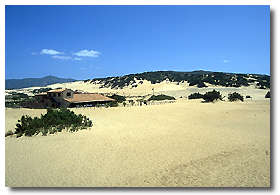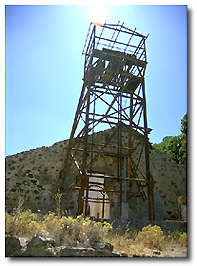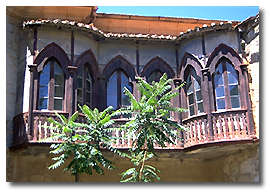On the coast of Piscinas a hotel, the so-called "Mine Hotel", has been built on the
ruins of an old store. This is an example of the intelligent use of an outpost that respects nature.
A few hundreds meters from the majestic dunes, a camping site has been built by utilizing, also in
this case, the buildings of the old mine. Here it is not rare to hear the bells of Sardinian deer,
the king of the wood, reigning once again in these valleys and mountains after having been near
extinction.
|
|

 Piscinas - Le Dune Hotel Piscinas - Le Dune Hotel |

 Ingurtosu - A mine shaft Ingurtosu - A mine shaft |
|
The charm of an unspoiled natural setting combines in an original way with the mining
civilization, with its buildings, its workshops, its mines, its galleries, nowadays deserted after
the depletion of the lead and zinc veins. In fact between Arbus and Guspini one can admire the most
enchanting examples of the Sardinian mining epoch. It is hard to describe the stir that Ingurtosu, the
great village, which was closed at the end of the 60s, arouses (the name "Ingurtosu"
derives from "su gurturgiu", which is the Sardinian name for the griffin vulture that,
not many years ago, could be admired in the sky).
|
In the past almost 5.000 people lived among these
valleys which are covered by pines and holm-oaks while nowadays no more than 100 people live here.
Ingurtosu is one of the most famous monuments of mining archaeology in the world. The mine
administration, the liberty style granite villas, the miners’ houses, the hospital, the old
mining elevators, the church and the school are plunged into a dream like landscape, which overlooks,
like a majestic natural balcony, the Costa Verde sea and in particular the dunes of Piscinas.
Old houses and stores, hidden by the green plants that grow luxuriantly, houses that are more
populated by goats and deer than by man.
|
|

 Ingurtosu - The mine's head office Ingurtosu - The mine's head office |
|